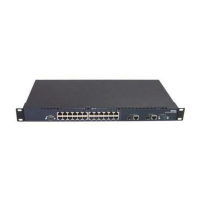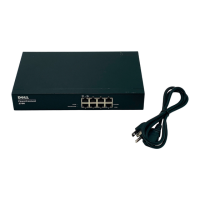1054 PowerConnect B-Series FCX Configuration Guide
53-1002266-01
Configuring route flap dampening
30
Configuring route flap dampening
A “route flap” is the change in a route state, from up to down or down to up. When a route state
changes, the state change causes changes in the route tables of the routers that support the route.
Frequent changes in a route state can cause Internet instability and add processing overhead to
the routers that support the route.
Route flap dampening is a mechanism that reduces the impact of route flap by changing a BGP4
router response to route state changes. When route flap dampening is configured, the Layer 3
Switch suppresses unstable routes until the route state changes reduce enough to meet an
acceptable degree of stability. The Dell implementation of route flap dampening is based on RFC
2439.
Route flap dampening is disabled by default. You can enable the feature globally or on an individual
route basis using route maps.
The Layer 3 Switch applies route flap dampening only to routes learned from EBGP neighbors.
The route flap dampening mechanism is based on penalties. When a route exceeds a configured
penalty value, the Layer 3 Switch stops using that route and also stops advertising it to other
routers. The mechanism also allows a route penalties to reduce over time if the route stability
improves. The route flap dampening mechanism uses the following parameters:
• Suppression threshold – Specifies the penalty value at which the Layer 3 Switch stops using
the route. Each time a route becomes unreachable or is withdrawn by a BGP4 UPDATE from a
neighbor, the route receives a penalty of 1000. By default, when a route has a penalty value
greater than 2000, the Layer 3 Switch stops using the route. Thus, by default, if a route goes
down more than twice, the Layer 3 Switch stops using the route. You can set the suppression
threshold to a value from 1 through 20000. The default is 2000.
• Half-life – Once a route has been assigned a penalty, the penalty decreases exponentially and
decreases by half after the half-life period. The default half-life period is 15 minutes. The
software reduces route penalties every five seconds. For example, if a route has a penalty of
2000 and does not receive any more penalties (it does not go down again) during the half-life,
the penalty is reduced to 1000 after the half-life expires. You can configure the half-life to be
from 1 through 45 minutes. The default is 15 minutes.
• Reuse threshold – Specifies the minimum penalty a route can have and still be suppressed by
the Layer 3 Switch. If the route's penalty falls below this value, the Layer 3 Switch
un-suppresses the route and can use it again. The software evaluates the dampened routes
every ten seconds and un-suppresses the routes that have penalties below the reuse
threshold. You can set the reuse threshold to a value from 1 through 20000. The default is
750.
• Maximum suppression time – Specifies the maximum number of minutes a route can be
suppressed regardless of how unstable the route has been before this time. You can set the
parameter to a value from
1 through 20000 minutes. The default is four times the half-life. When the half-life value is set
to its default (15 minutes), the maximum suppression time defaults to 60 minutes.
You can configure route flap dampening globally or for individual routes using route maps. If you
configure route flap dampening parameters globally and also use route maps, the settings in the
route maps override the global values.

